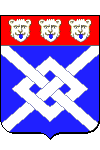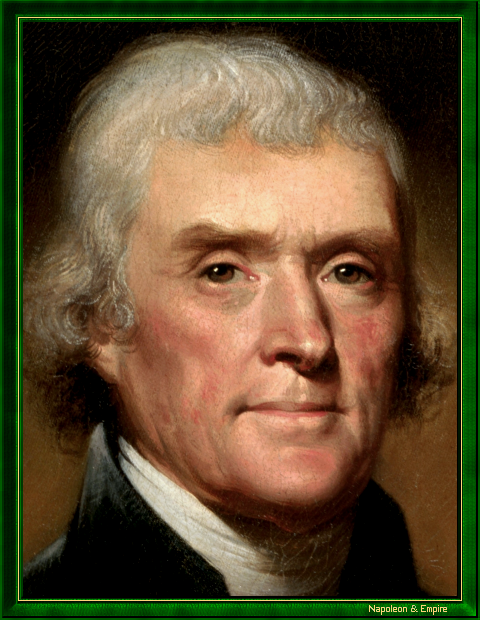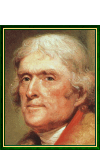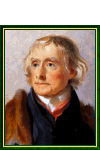President of the United States of America from 1801 to 1809

Thomas Jefferson was born on April 13, 1742 in Shadwell, Albemarle County, Virginia into a relatively wealthy family (his father owned a plantation).
The oldest of ten children, he inherited the family property at the age of 14 when his father died.
Jefferson studied at the College of William and Mary in Williamsburg, graduating in 1762. He continued to study law and was admitted to the bar in 1767.
In 1769, he was elected to the Virginia Legislature. Aware of the discontentment directed against the English, he published a pamphlet in 1774 entitled "A Summary View of the Rights of British America" which placed him at the forefront of American patriots.
In June 1776, Jefferson took part in the drafting of the Virginia Constitution. On July 1, he was elected to the five-man committee writing the United States Declaration of Independence as part of the Assembly of Philadelphia. This committee was composed of John Adams, Roger Sherman, Benjamin Franklin and Robert Livingston. It is generally accepted that Jefferson was the principal author of the text of the Declaration of Independence released on July 4, 1776.
In September 1776, he was elected to the newly formed Virginia House of Delegates where he advocated religious freedom, the separation of Church and State, and the abolition of the slave trade in 1778. From 1779 to 1781, he was Governor of Virginia.
Starting 1784, Jefferson served his young country as a diplomat. He left for Europe in May 1784 with Benjamin Franklin who he would succeed as United States Minister to France in May 1785. He held this post until August 1789. His work permitted him to profit from the literary culture of the French capital and to visit the rest of Western Europe. He returned to the United States in November 1789 after witnessing the first hours of the French Revolution.
In March 1790, George Washington chose Jefferson as Secretary of State. From the start, he was at odds with the Secretary of the Treasury, Alexander Hamilton, over the importance of reducing the national debt. The opposition between these two men led to the formation of two political parties: Jefferson's Republicans (stilled referred to by historians as the "Democratic-Republican Party" to avoid confusion with today's Republican Party) who called for a small federal government where each State was responsible for its own jurisdiction and Hamilton's Federalists who advocated for a strong federal government with an adaptable constitution and a mercantile economy rather than one based on agriculture. This marked the beginning of the two-party political system in the United States.
When England declared war on revolutionary France in 1793, Jefferson and Hamilton also disagreed over foreign policy; while Jefferson supported France, Hamilton was sympathetic toward the English. When the Jay Treaty committed George Washington's support to England over France, Thomas Jefferson resigned from the Government and returned to his Monticello property in Virginia.
In the presidential election of 1796, Thomas Jefferson came second behind the Federalist John Adams making him Vice-President according the electoral rules at the time. In the next election in November 1800, he took his revenge on the outgoing President by winning 73 votes in the Electoral College against Hamilton's 65. He became the third President of the United States of America.
During his first term as President from 1801 to 1805, Thomas Jefferson negotiated the Louisiana Purchase of 1803 for 15 million dollars that effectively doubled the size of the United States when sovereignty was transferred on December 20, 1803.
During his second term in office after being re-elected in 1804, he signed the Embargo Act of 1807, which quickly became ineffective and unpopular, as well as an act that made importing slaves into the Union illegal.
In the years following his presidency, he was actively involved in establishing the University of Virginia that he founded in 1819.
He died at Monticello, Virginia on July 4, 1826 exactly 50 years to the day after the signing of the Declaration of Independence, and only a few hours before his presidential predecessor John Adams.
"Thomas Jefferson", painted in 1800 by Rembrandt Peale (Bucks County, Pennsylvania 1778 - Philadelphia, Pennsylvania 1860).

When he was George Washington's Secretary of State, Jefferson had the idea of adopting the metric system in America, but his proposition was not adopted.
Acknowledgements
Other portraits

Enlarge
"Thomas Jefferson", painted in 1805 by Rembrandt Peale (Bucks County, Pennsylvania 1778 - Philadelphia, Pennsylvania 1860).

Enlarge
"Thomas Jefferson" by Thomas Sully (Horncastle, Lincolnshire 1783 - Philadelphia, Pennsylvania 1872).

Enlarge
"Thomas Jefferson" by Matthew Harris Jouett (Mercer County, Kentucky 1788 - Lexington, Kentucky 1827).